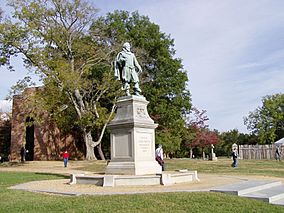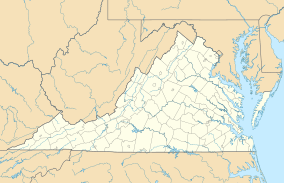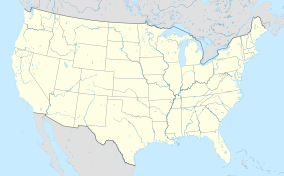Historic Jamestown facts for kids
Quick facts for kids Jamestown National Historic Site |
|
|---|---|

A statue of John Smith, English explorer and most famous of the colony's early governors
|
|
| Location | 1368 Colonial Parkway, Jamestown, Virginia, United States |
| Nearest city | Williamsburg, Virginia |
| Area | 20.63 acres (8.35 ha) |
| Established | December 18, 1940 |
| Governing body | Preservation Virginia (in partnership with NPS) |
| Website | Historic Jamestowne |
|
Jamestown National Historic Site
|
|
| Location | James City, Colony of Virginia |
| Built | May 14, 1607 |
| NRHP reference No. | 66000840 |
| Significant dates | |
| Added to NRHP | October 15, 1966 |
Historic Jamestown is a super important place in America! It's where the very first permanent English settlement, called James Fort, was built way back in 1607. Later, a town grew up around it. You can find it on Jamestown Island, right by the James River in Jamestown, Virginia.
Today, it's a special place managed by two groups, Preservation Virginia and the U.S. National Park Service. They work together to teach everyone about its amazing history. This site was officially named the Jamestown National Historic Site in 1940. It's also recognized as a National Historic Chemical Landmark because of its early scientific discoveries. Right next door is Jamestown Settlement, a fun museum that shows what life was like in the early colony.
Contents
Jamestown's Early Days
The First English Settlement
Imagine sailing across the ocean in 1607! That's what about a hundred English colonists did to start Jamestown. They picked this spot in Virginia to build their new home. Their first job was to build a fort to protect themselves. They needed to be safe from local Virginia Indian tribes and possible attacks from the Spanish.
Tough Times and New Beginnings
Life was incredibly hard for the early colonists. Between 1609 and 1610, they faced a terrible period called the "starving time." There wasn't enough food, supplies from England were slow to arrive, and many got sick. Only about 60 colonists survived this difficult time.
Luckily, new colonists and supplies soon arrived, helping the settlement grow. Over the next few decades, Jamestown became the main center for the English colony. Many more people arrived from England, and at its busiest, about 500 people lived in or near the town. In 1619, the first Africans were brought to the colony. One of them was a woman named Angela.
Jamestown as Capital
Jamestown was the capital city of the Virginia Colony for many years. But in 1676, during a conflict called Bacon's Rebellion, much of the town was burned down. The colonists rebuilt it, but then it accidentally burned down again in 1698.
After this second fire, leaders decided to move the capital to a higher, safer location nearby. This new spot was called Middle Plantation, and it was later renamed Williamsburg. Once Jamestown was no longer the capital, it quickly became a much smaller settlement. By the 1750s, it was mostly farmland.
Jamestown During Wars
Because Jamestown Island is on the James River, it played a small part in the American Revolutionary War (1776–1781). It was used as a military spot where American and British prisoners of war were exchanged.
Later, during the American Civil War in the 1860s, the island was used by soldiers. The Confederate army built defenses there to protect against Union ships. The Ambler Farm on the island was burned by escaped slaves who found safety there. After the war, the area went back to being farmland until people started working to preserve its history.
Why Jamestown Matters Today
Jamestown Rediscovery, the group working at the site, is dedicated to protecting, teaching about, and digging up the history of Historic Jamestowne. They want to make sure everyone understands this original site of the first permanent English settlement in America.
Protecting Jamestown's History
Saving the Island
In the late 1800s, people became very interested in Jamestown's history again. By 1893, a couple named Mr. and Mrs. Edward Barney owned the land. They generously gave 22.5 acres of Jamestown Island, including the old 17th-century tower of the Jamestown Church, to Preservation Virginia.
At this time, the river was slowly washing away the island's western shore. Many thought the original James Fort was completely underwater! To stop this, a strong sea wall was built in 1900. In 1907, for the 300th anniversary, the current Jamestown Church was rebuilt, using the original 17th-century tower.
Discovering the Past
In 1932, a man named George C. Gregory found the foundation of the first capitol building from around 1646. A few years later, in 1934, the Colonial National Historical Park took over the rest of the island. They teamed up with Preservation Virginia to protect the area and teach visitors about its history.
The National Park Service now takes care of the rest of the island. They have even recreated the foundations of buildings from the post-1610 Jamestown town.
Finding James Fort
In 1994, as the 400th anniversary of Jamestown was getting closer, Preservation Virginia started a big archaeology project called Jamestown Rediscovery. Led by William Kelso, they searched for any remains of James Fort. By 1996, they had found it! Most of the fort was still there, with only a small part lost to river erosion.
Celebrating 400 Years
In 2006 and 2007, many preparations were made for the Jamestown 2007 event, celebrating 400 years since the settlement began. Important people like President George W. Bush and Queen Elizabeth II visited the site. Queen Elizabeth noted that Jamestown was the start not just of America, but of the British Empire.
Important Places and Monuments
The Historic Jamestowne area on Jamestown Island has many important structures, both old ruins and newer monuments.
Old Town Area
This part of the site includes the remains of the original 1607 James Fort. You can also see the restored Jamestown Church and the ruins of the old Statehouse building here.
New Town Area
Just east of the Old Town, you'll find the ruins of the Ambler Mansion, a rowhouse, and the Governor Harvey House. These show how the town grew beyond the fort.
Special Monuments
Tercentenary Monument
The tall Tercentenary Monument looks a bit like the Washington Monument. It was placed on Jamestown Island by the U.S. government in 1907 for the 300th anniversary. It stands 103 feet tall and is made of granite. An inscription on it says: "Jamestown - The first permanent colony of the English people. The birthplace of Virginia and of the United States - May 13, 1607."
General Assembly Monument
This small monument, shaped like a tall, thin pillar, was put up in 1907. It remembers the very first meeting of Virginia's General Assembly in July 1619. This was an important step for self-government in America.
John Smith Statue
A bronze statue of John Smith was unveiled in 1909. John Smith was an important leader and governor of the colony. The statue is 20 feet tall and has his motto, "vincere est vivere," which means "to live is to conquer."
Pocahontas Statue
The bronze Pocahontas statue was first put up in 1922. It honors the famous Native American woman who played a role in the early colony. It was moved in 1957 and again in 2014 for archaeological work.
Hunt Shrine
Also from 1922, the Hunt Shrine honors Robert Hunt, the first Anglican minister of the colony. It has a carving that shows the 1607 church service. An inscription from John Smith talks about how important Hunt was to the colonists.
Wooden Cross
Near the entrance to the Archaearium museum, a wooden cross stands. It was put up in 1957 to remember the early settlers who died in Jamestown's first difficult years. Their bodies are believed to be buried nearby.
Voorhees Archaearium Museum
The Nathalie P. and Alan M. Voorhees Archaearium is a fantastic museum right at Historic Jamestowne. It displays many artifacts that archaeologists have dug up from the site. The building is even built over the excavated remains of the last Statehouse in Jamestown, so you can see history right under your feet! The museum shows objects that belonged to the colonists 400 years ago, helping you imagine what their lives were like.
Gallery
-
Pocahontas statue, July 2007
See also














